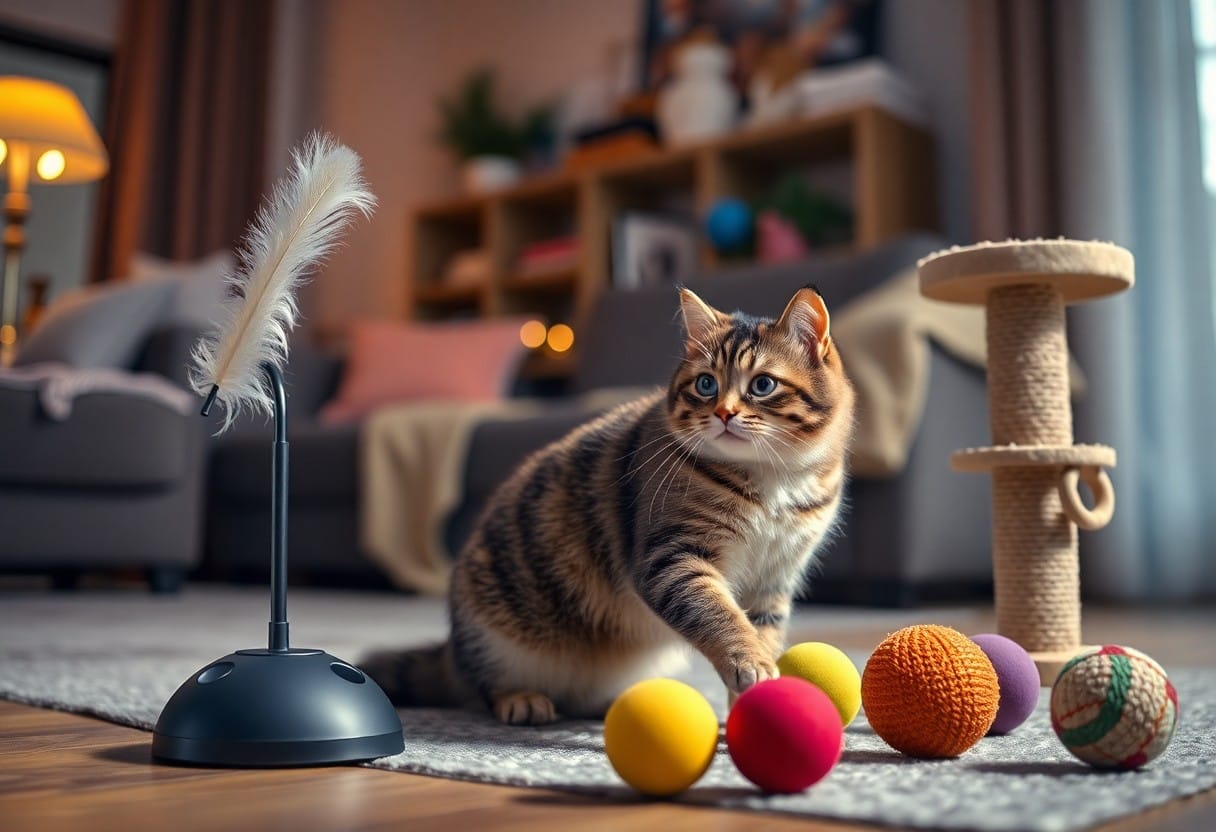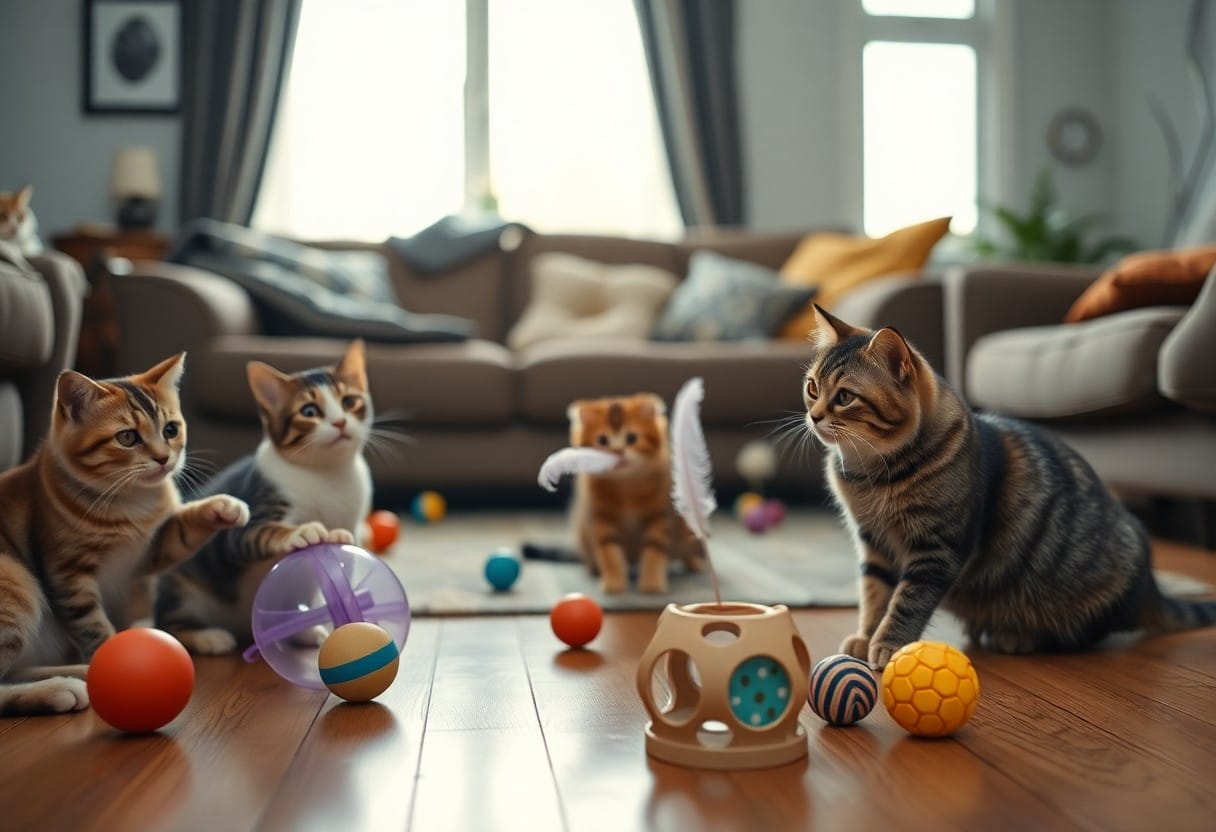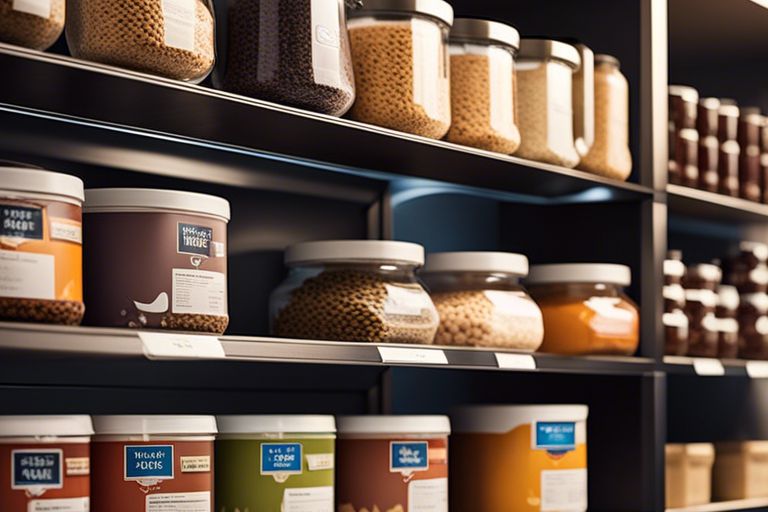Guide your way through the myriad of options with our comprehensive manual on selecting the finest cat treats for your feline companion. Delve into the world of tantalizing flavors, imperative ingredients, and nutritional benefits to ensure your fur baby gets the best of the best. Trust our expert suggestions to pamper your whiskered friend with only the top-tier treats that will have their tail wagging in delight.
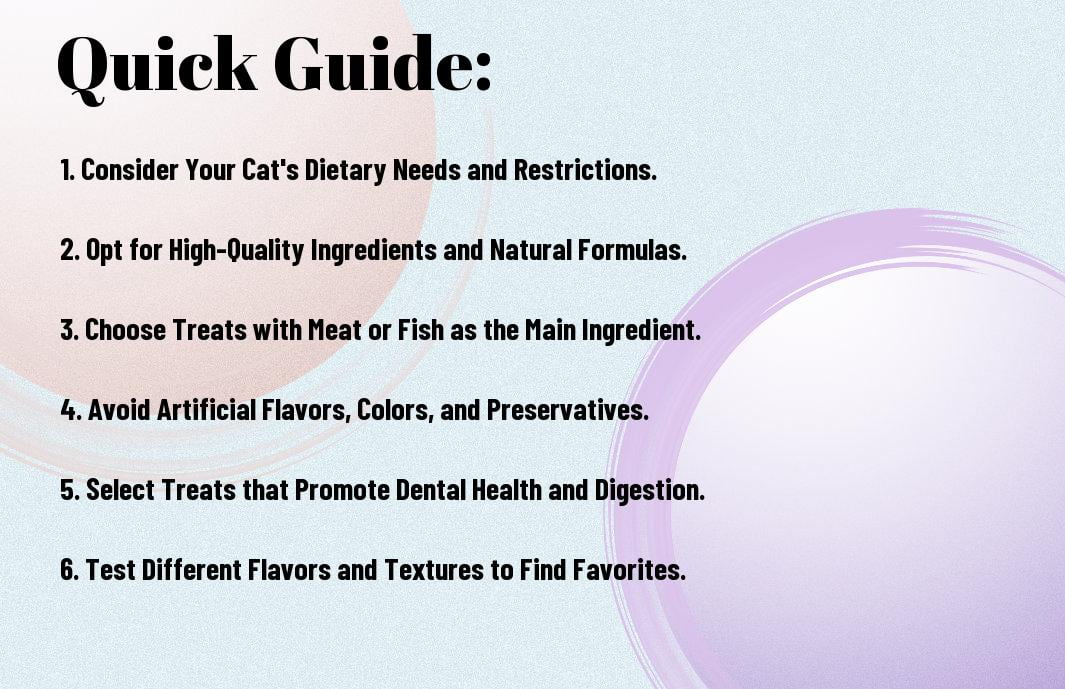
Understanding Your Cat’s Nutritional Needs
Essential Nutrients for Cats
Nutritional balance is crucial for maintaining your cat’s overall health and well-being. Cats are obligate carnivores, which means they have specific dietary requirements that must be met through their food. Essential nutrients for cats include proteins, fats, vitamins, and minerals. Proteins are particularly important for cats as they require high-quality sources of protein for muscle growth and maintenance.
Treats vs. Regular Diet
While treats can be a fun way to bond with your cat and provide them with extra enjoyment, it’s crucial to remember that they should not replace a balanced diet. Treats are typically high in calories and may lack crucial nutrients that are necessary for your cat’s health. It’s important to offer treats in moderation and ensure that they complement your cat’s regular diet.
Diet plays a significant role in your cat’s overall health, and a well-balanced diet is key to ensuring they receive all the necessary nutrients. Regular cat food is specially formulated to provide all the crucial nutrients your cat needs to thrive. Treats should be given sparingly and not make up a significant portion of your cat’s daily caloric intake.
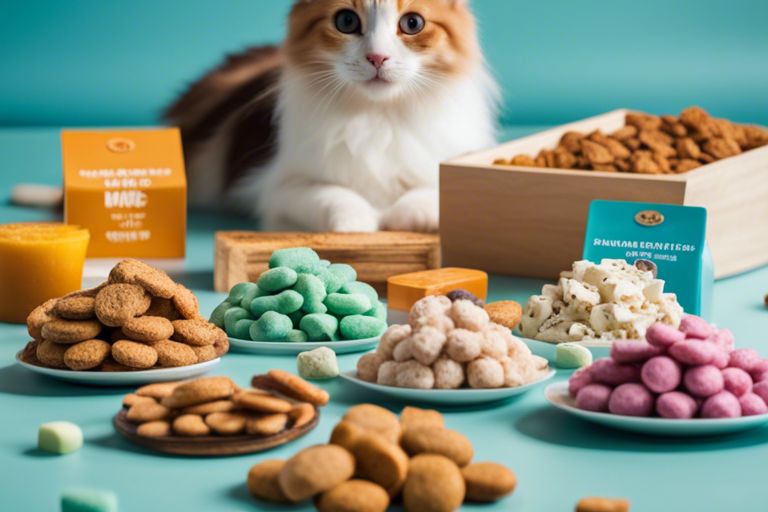
Types of Cat Treats
You must consider the types of cat treats available in the market as you choose the best ones for your feline friend. Knowing the different options will help you make an informed decision based on your cat’s preferences and dietary needs.
| Crunchy Treats | Soft Treats |
| Freeze-Dried Options | Dental Health Treats |
| Homemade vs. Commercial Treats |
Crunchy Treats and Their Benefits
Crunchy treats provide dental benefits by helping to reduce plaque and tartar buildup on your cat’s teeth. The crunchy texture also gives your cat’s jaws a workout, promoting dental health and reducing the risk of dental issues. Additionally, these treats can be a great option for cats who enjoy a satisfying crunch in their snacks.
Soft Treats and Their Advantages
Types of soft treats offer the advantage of being easy to chew and digest, making them suitable for cats of all ages, including kittens and senior cats. These treats are often moist and flavorful, making them appealing to picky eaters. Plus, soft treats can be a good option for cats with dental issues or sensitive teeth.
Freeze-Dried Options
The freeze-drying process involves removing moisture from the treats without using heat, which helps retain the nutrients and flavors of the ingredients. Freeze-dried options are lightweight, making them convenient for storage and travel. These treats are also shelf-stable and often made with minimal ingredients, making them a healthy choice for your cat.
Dental Health Treats
Soft dental treats are specifically formulated to promote oral health by reducing plaque and tartar buildup while freshening your cat’s breath. These treats typically contain ingredients like chlorophyll or enzymes to support dental hygiene. FreezingDried Some dental treats may also have a crunchy texture to help clean your cat’s teeth as they chew.
Homemade vs. Commercial Treats
Any cat owner may consider making homemade treats for their feline companion, but it’s imperative to ensure the treats are nutritionally balanced and safe for your cat to consume. Commercial treats, on the other hand, are convenient and come in a variety of flavors and formulations tailored to meet specific dietary needs. Treats It’s crucial to choose treats from reputable brands that prioritize your cat’s health and well-being.
Factors to Consider When Choosing Cat Treats
- Ingredient Quality and Sourcing
- Your Cat’s Age and Health Conditions
- Allergies and Food Sensitivities
- Texture and Palatability Preferences
Ingredient Quality and Sourcing
Factors such as the quality and sourcing of ingredients in cat treats should be at the top of your list when selecting the best treats for your feline friend. Look for treats made with high-quality proteins, such as real meat, and avoid those with fillers, artificial flavors, and colors. Opt for treats that are made with natural and wholesome ingredients to ensure your cat is getting the best nutrition possible.
Assume that treats made with organic or human-grade ingredients are a safer and healthier option for your cat.
Your Cat’s Age and Health Conditions
Even though treats are usually given in small quantities, they can still have an impact on your cat’s overall health, especially if they have specific health conditions or dietary requirements. Consider your cat’s age and any health issues they may have when choosing treats. For example, older cats may benefit from treats with added joint support, while cats with dental problems may need softer treats.
Quality treats tailored to your cat’s specific age and health needs can help support their wellbeing and keep them happy and healthy.
Allergies and Food Sensitivities
Some cats may have allergies or food sensitivities to certain ingredients commonly found in cat treats, such as grains, soy, or certain proteins. It’s crucial to be aware of your cat’s dietary restrictions and choose treats that are free from any known allergens. Opt for treats that are labeled as hypoallergenic or limited ingredient to minimize the risk of triggering any adverse reactions.
Sensitivities to certain ingredients can lead to digestive upset or skin irritations in cats, so it’s crucial to choose treats that are safe for your feline friend.
Texture and Palatability Preferences
Allergies to certain textures may be a concern for some cats, so it’s crucial to consider your cat’s preferences when selecting treats. Some cats may prefer crunchy treats, while others may prefer softer, chewy options. Pay attention to your cat’s reactions and adjust their treats accordingly to ensure they enjoy their snack time.
Palatability is key when it comes to cat treats, so experimenting with different textures can help you determine what your cat loves best.

The Pros and Cons of Popular Cat Treat Options
Many cat owners love to spoil their furry friends with a variety of treats, but not all treats are created equal. It’s important to understand the pros and cons of popular cat treat options before deciding which ones to incorporate into your cat’s diet. Below is a breakdown of the benefits and potential drawbacks of some common cat treat choices to help you make an informed decision.
| Option | Pros and Cons |
| Freeze-Dried Treats | Pros: High in protein, minimal processing Cons: Expensive, can be high in calories |
| Soft Treats | Pros: Easy to chew, come in various flavors Cons: Some may contain fillers and additives |
| Grain-Free Treats | Pros: Ideal for cats with sensitive stomachs, lower in carbohydrates Cons: May lack some important nutrients |
| Dental Treats | Pros: Promote dental health, help reduce tartar buildup Cons: Some may not be effective, should not replace regular dental care |
Understanding the Benefits of Different Treats
Understanding the benefits of different cat treats can help you choose the right option for your feline friend. Freeze-dried treats are a popular choice because they retain most of their nutrients due to minimal processing. They are also high in protein, which is important for your cat’s overall health.
On the other hand, soft treats are great for cats that may have dental issues or difficulty chewing. They come in various flavors that cats love, making them a versatile option for rewarding your pet.
Potential Drawbacks to be Aware Of
Now, let’s discuss potential drawbacks to be aware of when it comes to cat treats. While freeze-dried treats are nutrient-dense, they can be expensive and high in calories, so it’s crucial to watch the portion sizes to avoid weight gain in your cat. Similarly, soft treats may contain fillers and additives that could be harmful to your cat’s health if consumed in excess.
Popular cat treat options offer a wide range of benefits and drawbacks that cat owners should consider. By understanding the pros and cons of different treats, you can make an informed decision to provide your cat with tasty rewards while ensuring their overall well-being.
Step-by-Step Guide to Introducing New Treats
Not all cat treats are created equal, and introducing new treats to your feline friend should be done with care and consideration. Follow this step-by-step guide to ensure a smooth transition and a happy kitty.
| 1. Monitoring Your Cat’s Initial Reactions | 2. Determining the Right Serving Size |
Monitoring Your Cat’s Initial Reactions
Monitoring your cat’s initial reactions to a new treat is crucial. Watch for any signs of allergies or sensitivities such as vomiting, diarrhea, or excessive itching. It’s also important to observe their overall enjoyment of the treat to ensure it’s a good fit for them.
Determining the Right Serving Size
Now, when introducing a new treat, it’s important to determine the right serving size for your cat. Start with small portions to avoid overfeeding or digestive issues. Monitor how your cat reacts to the new treat and adjust the serving size accordingly.
Another key factor in determining the right serving size is considering your cat’s overall daily caloric intake. Treats should only make up a small percentage of their diet to ensure they maintain a healthy weight and balanced nutrition.
Balancing Treats with a Regular Diet
To maintain a healthy diet for your cat, it’s crucial to balance the treats they consume with their regular meals. While treats can be a fun addition to their diet, they should not replace the crucial nutrients provided by their main food. Always consult with your veterinarian to ensure your cat’s diet is well-balanced.
Tips for Responsible Treat Giving
Despite being a wonderful way to bond with your feline friend, it’s crucial to be mindful of how often and what treats you’re giving them. Here are some tips for responsible treat giving:
- Avoid overfeeding and observe dietary limits
- Using treats for training and bonding
Avoid Overfeeding and Observe Dietary Limits
Any treats should be given in moderation, taking into account the overall caloric intake of your cat’s diet. It’s necessary to balance treats with their regular meals to ensure they are receiving the necessary nutrients without going over their daily calorie limit. Additionally, consider the specific dietary needs of your cat, especially if they have any health issues such as diabetes or obesity.
Assume that treats should make up no more than 10% of your cat’s daily caloric intake and opt for high-quality treats made with real ingredients to avoid unnecessary fillers that could lead to weight gain or digestive issues.
Using Treats for Training and Bonding
Any training sessions with your cat can be enhanced by using treats as a positive reinforcement. Whether you’re teaching them new tricks or simply rewarding good behavior, treats can be a powerful tool in strengthening your bond with your feline companion. Responsible treat giving during these sessions can help build trust and communication between you and your cat.
Responsible treat giving can also be a way to create special bonding moments with your cat, whether it’s through interactive play or simply spending quality time together. Consider using treats as a way to encourage positive behavior and strengthen the connection between you and your beloved pet.
Conclusion
Now you have a comprehensive guide to help you choose the best cat treats for your feline friend. By considering factors such as your cat’s nutritional needs, preferences, and any dietary restrictions, you can find the perfect treats to keep them happy and healthy. Remember to look for treats with high-quality ingredients and to consult with your veterinarian if you have any concerns about your cat’s dietary requirements.
With the right cat treats, you can strengthen the bond with your cat, reward them for good behavior, and provide them with additional nutrition. Treats should be given in moderation and as part of a balanced diet to ensure that your cat stays healthy and happy. By following this guide, you can make informed decisions when selecting the best treats for your furry companion.
FAQ
Q: Why are cat treats important for my pet?
A: Cat treats are important for your pet because they provide a way to strengthen the bond between you and your cat, and they can also be used for training purposes. Additionally, treats can offer variety in your cat’s diet and can help with dental health.
Q: What should I look for when choosing cat treats?
A: When choosing cat treats, look for ones that are made with high-quality ingredients, such as real meat, and are free from artificial colors, flavors, and preservatives. It’s also important to consider your cat’s dietary needs and any food sensitivities they may have.
Q: How many treats should I give my cat?
A: Treats should make up only a small percentage of your cat’s daily caloric intake, typically around 10%. Consult with your veterinarian to determine the appropriate amount of treats for your cat based on their age, weight, and activity level.
Q: Are there any treats I should avoid giving to my cat?
A: Yes, you should avoid giving your cat treats that are high in carbohydrates, fillers, and artificial ingredients. Treats that contain ingredients such as corn, wheat, and soy should also be avoided, as these can be difficult for cats to digest.
Q: How can I use cat treats in training my cat?
A: Cat treats can be used in training as positive reinforcement for good behavior. Use small, soft treats that your cat can easily consume and offer them immediately after your cat performs the desired behavior. Consistency and patience are key when using treats in training.

